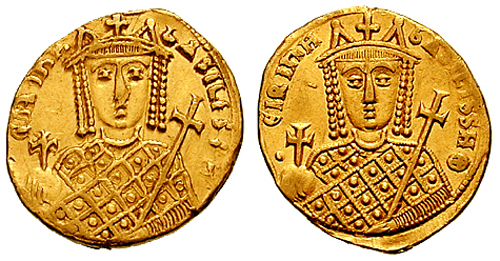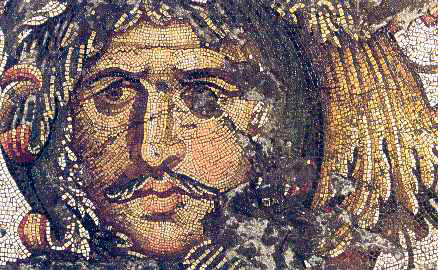|
Bardanes Tourkos
Bardanes, nicknamed ''Tourkos'', "the Turk" ( gr, Βαρδάνης ὁ Τοῦρκος, Bardanēs ho Tourkos, ), was a Byzantine general of Armenian origin who launched an unsuccessful rebellion against Emperor Nikephoros I () in 803. Although a major supporter of Byzantine empress Irene of Athens (), soon after her overthrow he was appointed by Nikephoros as commander-in-chief of the Anatolian armies. From this position, he launched a revolt in July 803, probably in opposition to Nikephoros's economic and religious policies. His troops marched towards Constantinople, but failed to win popular support. At this point, some of his major supporters deserted him and, reluctant to engage the loyalist forces in battle, Bardanes gave up and chose to surrender himself. He retired as a monk to a monastery he had founded. There he was blinded, possibly on Nikephoros's orders. Origin and early career Nothing is known of the early life of Bardanes. He is usually regarded by modern scholars a ... [...More Info...] [...Related Items...] OR: [Wikipedia] [Google] [Baidu] |
Byzantine Empire
The Byzantine Empire, also referred to as the Eastern Roman Empire or Byzantium, was the continuation of the Roman Empire primarily in its eastern provinces during Late Antiquity and the Middle Ages, when its capital city was Constantinople. It survived the fragmentation and fall of the Western Roman Empire in the 5th century AD and continued to exist for an additional thousand years until the fall of Constantinople to the Ottoman Empire in 1453. During most of its existence, the empire remained the most powerful economic, cultural, and military force in Europe. The terms "Byzantine Empire" and "Eastern Roman Empire" were coined after the end of the realm; its citizens continued to refer to their empire as the Roman Empire, and to themselves as Romans—a term which Greeks continued to use for themselves into Ottoman times. Although the Roman state continued and its traditions were maintained, modern historians prefer to differentiate the Byzantine Empire from Ancient Rome ... [...More Info...] [...Related Items...] OR: [Wikipedia] [Google] [Baidu] |
Theophanes The Confessor
Theophanes the Confessor ( el, Θεοφάνης Ὁμολογητής; c. 758/760 – 12 March 817/818) was a member of the Byzantine aristocracy who became a monk and chronicler. He served in the court of Emperor Leo IV the Khazar before taking up the religious life. Theophanes attended the Second Council of Nicaea in 787 and resisted the iconoclasm of Leo V the Armenian, for which he was imprisoned. He died shortly after his release. Theophanes the Confessor, venerated on 12 March in both the Eastern Orthodox and the Roman Catholic churches, should not be confused with Theophanes of Nicaea, whose feast is commemorated on 11 October. Biography Theophanes was born in Constantinople of wealthy and noble iconodule parents: Isaac, governor of the islands of the Aegean Sea, and Theodora, of whose family nothing is known. His father died when Theophanes was three years old, and the Byzantine Emperor Constantine V (740–775) subsequently saw to the boy's education and upbringing at t ... [...More Info...] [...Related Items...] OR: [Wikipedia] [Google] [Baidu] |
Monostrategos
''Strategos'', plural ''strategoi'', Latinized ''strategus'', ( el, στρατηγός, pl. στρατηγοί; Doric Greek: στραταγός, ''stratagos''; meaning "army leader") is used in Greek to mean military general. In the Hellenistic world and the Eastern Roman Empire the term was also used to describe a military governor. In the modern Hellenic Army, it is the highest officer rank. Etymology ''Strategos'' is a compound of two Greek words: ''stratos'' and ''agos''. ''Stratos'' (στρατός) means "army", literally "that which is spread out", coming from the proto-Indo-European root *stere- "to spread". ''Agos'' (ἀγός) means "leader", from ''agein'' (ἄγειν) "to lead", from the proto-Ιndo-Εuropean root *ag- "to drive, draw out or forth, move”. Classical Greece Athens In its most famous attestation, in Classical Athens, the office of ''strategos'' existed already in the 6th century BC, but it was only with the reforms of Cleisthenes in 501 BC ... [...More Info...] [...Related Items...] OR: [Wikipedia] [Google] [Baidu] |
Abbasid Caliphate
The Abbasid Caliphate ( or ; ar, الْخِلَافَةُ الْعَبَّاسِيَّة, ') was the third caliphate to succeed the Islamic prophet Muhammad. It was founded by a dynasty descended from Muhammad's uncle, Abbas ibn Abdul-Muttalib (566–653 CE), from whom the dynasty takes its name. They ruled as caliphs for most of the caliphate from their capital in Baghdad in modern-day Iraq, after having overthrown the Umayyad Caliphate in the Abbasid Revolution of 750 CE (132 AH). The Abbasid Caliphate first centered its government in Kufa, modern-day Iraq, but in 762 the caliph Al-Mansur founded the city of Baghdad, near the ancient Babylonian capital city of Babylon. Baghdad became the center of science, culture and invention in what became known as the Golden Age of Islam. This, in addition to housing several key academic institutions, including the House of Wisdom, as well as a multiethnic and multi-religious environment, garnered it a worldwide reputation as the ... [...More Info...] [...Related Items...] OR: [Wikipedia] [Google] [Baidu] |
Logothetes Tou Genikou
The ( gr, λογοθέτης τοῦ γενικοῦ, often called or simply (, 'the general ogothete), and usually rendered in English as the General Logothete, was in charge of the 'general financial ministry', the of the middle Byzantine Empire.. History and functions The was responsible for general taxation and revenue, and also served as a court for financial cases. As such, it broadly fulfilled the tasks of the earlier , although it was mostly derived from the "general department" of the praetorian prefecture. The first attested , the monk Theodotos, is mentioned in 692, but the post may have been instituted as early as 626. The bureau of the and its logothete remained one of the chief ministries for the entire middle Byzantine period (7th–12th centuries). During the Komnenian period, its importance declined, but recovered under the Angeloi. Following the sack of Constantinople in 1204 and the dissolution of the Byzantine Empire, the office of the was retained as ... [...More Info...] [...Related Items...] OR: [Wikipedia] [Google] [Baidu] |
Church Of The Holy Apostles
The Church of the Holy Apostles ( el, , ''Agioi Apostoloi''; tr, Havariyyun Kilisesi), also known as the ''Imperial Polyándreion'' (imperial cemetery), was a Byzantine Eastern Orthodox church in Constantinople, capital of the Eastern Roman Empire. The first structure dated to the 4th century, though future emperors would add to and improve upon it.Krautheimer (1992) It was second in size and importance only to the Hagia Sophia among the great churches of the capital. When Fall of Constantinople, Constantinople fell to the Ottoman Empire, Ottomans in 1453, the Holy Apostles briefly became the seat of the Ecumenical Patriarch of the Eastern Orthodox Church. Three years later the dilapidated edifice was abandoned, and the patriarchate was moved to the Pammakaristos Church, Theotokos Pammakaristos Church. In 1461, the church of the Holy Apostles was demolished by the Ottomans to make way for the Fatih Mosque, Istanbul, Fatih Mosque.Müller-Wiener (1977) p. 406 History The ori ... [...More Info...] [...Related Items...] OR: [Wikipedia] [Google] [Baidu] |
Great Palace Of Constantinople
The Great Palace of Constantinople ( el, Μέγα Παλάτιον, ''Méga Palátion''; Latin: ''Palatium Magnum''), also known as the Sacred Palace ( el, Ἱερὸν Παλάτιον, ''Hieròn Palátion''; Latin: ''Sacrum Palatium''), was the large imperial Byzantine palace complex located in the south-eastern end of the peninsula now known as Old Istanbul (formerly Constantinople), in modern Turkey. It served as the main imperial residence of the Eastern Roman or Byzantine emperors until 1081 and was the centre of imperial administration for over 690 years. Only a few remnants and fragments of its foundations have survived into the present day. History When Constantine I refounded Byzantium as Constantinople in 330, he planned out a palace for himself. The palace was located between the Hippodrome and Hagia Sophia. The complex of palaces was rebuilt and expanded several times during its history. Much of the complex was destroyed during the Nika riots of 532 and was rebuil ... [...More Info...] [...Related Items...] OR: [Wikipedia] [Google] [Baidu] |
Sisinnios Triphyllios
Sisinnios Triphyllios ( el, Σισίννιος Τριφύλλιος, died 26 July 811) was one of the senior dignitaries of the Roman Empire during the reign of Empress Irene of Athens (797–802) and her successor Emperor Nikephoros I (802–811). Sisinnios first appears in Irene's unique triumphal procession on Easter Monday, 1 April 799, through the imperial capital, Constantinople. At the time, he held the post of '' strategos'' (military governor) of Thrace, the theme closest to Constantinople, and holder of the supreme dignity of ''patrikios''. He was one of the four ''patrikioi'' (along with Bardanes Tourkos Bardanes, nicknamed ''Tourkos'', "the Turk" ( gr, Βαρδάνης ὁ Τοῦρκος, Bardanēs ho Tourkos, ), was a Byzantine general of Armenian origin who launched an unsuccessful rebellion against Emperor Nikephoros I () in 803. Although ..., Constantine Boilas, and Sisinnios' brother Niketas) leading the four white horses which drew the imperial carriage, ... [...More Info...] [...Related Items...] OR: [Wikipedia] [Google] [Baidu] |
Niketas Triphyllios
Niketas Triphyllios ( el, Νικήτας Τριφύλλιος, died 30 April 803) was one of the highest officials of the Roman Empire during the reign of empress Irene of Athens (797–802), holding the position of Domestic of the Schools. Niketas first appears in Irene's unique triumphal procession on Easter Monday, 1 April 799. At the time, he was already Domestic of the Schools (commander of the elite '' Scholai'' regiment) and holder of the supreme dignity of ''patrikios''. Niketas was one of the four ''patrikioi'' (along with Bardanes Tourkos, Constantine Boilas, and Niketas' brother Sisinnios) leading the four white horses which drew the imperial carriage, a role that marks him out as one of the most prominent of Irene's supporters among the high dignitaries of the state.Guilland (1967), p. 436 A few weeks later, in May, Irene's health worsened considerably and the issue of her succession became opened. At this point Niketas (and possibly his brother too) allied himself wi ... [...More Info...] [...Related Items...] OR: [Wikipedia] [Google] [Baidu] |
Theodote
Theodote (Greek: Θεοδότη; 780 – after 797) was the second Empress consort of Constantine VI of the Byzantine Empire. She was a member of a distinguished family of Constantinople and her brother Sergios was mentioned as an ''hypatos''. Their mother Anna was a sister of Theoktiste and her brother Plato. Theodote was thus a maternal first cousin of Theodore the Studite, son of Theoktiste. Marriage By 794, Theodote served as a lady-in-waiting ('' koubikoularia'') of Irene. Irene was the widow of Leo IV the Khazar and mother of his heir Constantine VI. Irene had served as regent from 780 to 790 and still held the title of Empress. Constantine was married to Maria of Amnia and the imperial couple had two daughters, Euphrosyne and a younger Irene. However, according to the chronicle of Theophanes the Confessor, Constantine had turned against his first wife at some point. Theophanes attributed the deterioration of the marriage to the machinations of Irene, but the lack of a male ... [...More Info...] [...Related Items...] OR: [Wikipedia] [Google] [Baidu] |


.jpg)


